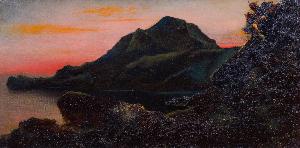Karl Wilhelm Diefenbach
None;Karl Wilhelm Diefenbach
Place: Hadamar
Born: 1851
Death: 1913
Biography:
Karl Wilhelm Diefenbach was a German painter and social reformer born on February 21, 1851, in Hadamar, Germany. He is considered to be an important pioneer of the Lebensreform (life-reform) ideas, a movement that criticized industrialization, materialism, and urbanization, and strived for a return to nature. Diefenbach's artistic style was characterized by symbolism, and he is regarded as the 'forefather of alternative movements' and one of the most important champions of Freikörperkultur (naturism) and the peace movement.
Early Life and Career
Diefenbach attended the Munich Academy of Fine Arts, where he was impressed by Arnold Böcklin and Franz von Stuck. However, his artistic endeavors were temporarily cut short due to a severe typhoid fever and a botched operation that left his right arm crippled. He had to learn all activities, including writing and painting, with his left hand. This experience led him to adopt naturopathic methods and transform himself into an apostle of the natural way of life.
Artistic Style and Influences
Diefenbach's artistic style was influenced by symbolism, and he is known for his Karl Wilhelm Diefenbach paintings that showcased his mastery of light and color. His work was also influenced by the Lebensreform movement, which emphasized the importance of living in harmony with nature. Diefenbach's contemporaries, such as Fidus, also explored similar themes in their work, including the idea of universal animation and the cult of evolution theory. Some notable paintings by Diefenbach include Capri, Monte Solaro at the sunset, which can be found on Wikioo.org. This painting showcases Diefenbach's ability to capture the mood and atmosphere of a scene, and it is an excellent example of his symbolism style.
Legacy and Influence
Diefenbach's legacy extends beyond his artistic work. He was a pioneer of the Lebensreform movement, which emphasized the importance of living in harmony with nature. His ideas about naturism, veganism, and the rejection of institutional religion were influential in shaping the German Youth Movement and Wandervogel groups. Diefenbach's rural commune Himmelhof, in Ober Sankt Veit near Vienna, was also a model for the reform settlement Monte Verità near Ascona, founded by his student Gustav Gräser.
- Visit the Lehmbruck Museum on Wikioo.org to explore more of Diefenbach's work and other notable artists.
- Learn more about the Lebensreform movement and its influence on art and society on Wikipedia.
- Discover the works of other artists, such as Fidus, who explored similar themes in their work, including the idea of universal animation and the cult of evolution theory.
Diefenbach's life and work serve as an inspiration to those who seek to live in harmony with nature and reject the conventions of modern society. His legacy continues to influence artists and thinkers today, and his paintings remain a testament to the power of symbolism and the human spirit.


